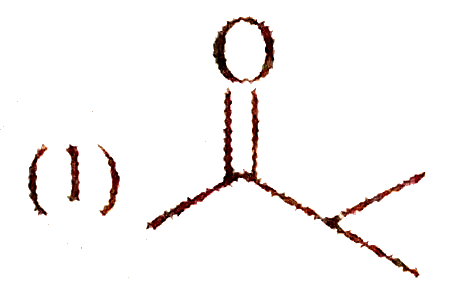What is the role of metal or reagents written on arrows in the given chemical reactions?
(a) CH3 \ C /CH3=C CH3/\ CH3+H2Ni−−→CH3−CH3∣C∣H−CH3∣C∣H−CH3
(b) CH3COOH+CH3CH2OHConc. H2SO4−−−−−−−−→CH3COOC2H5+H2O
(c ) CH3CH2OHAlk. KMnO4−−−−−−−→HeatCH3COOH
To understand the role of metals or reagents written on arrows in the given chemical reactions, let’s analyze each reaction step by step.
(a) Reaction:
CH3 \ C /CH3=C CH3/\ CH3+H2Ni−−→CH3−CH3∣C∣H−CH3∣C∣H−CH3
Step 1: Identify the reactants and products.
- The reactants are alkenes (with a double bond) and the product is an alkane (with single bonds).
Step 2: Determine the type of reaction.
- This reaction is a hydrogenation reaction, where hydrogen is added to the unsaturated alkene to form a saturated alkane.
Step 3: Analyze the role of Ni (Nickel).
- Nickel (Ni) is written above the arrow, indicating it acts as a catalyst in this reaction.
Step 4: Define the role of a catalyst.
- A catalyst increases the rate of a reaction without being consumed in the process. In this case, Ni facilitates the addition of hydrogen to the alkene.
(b) Reaction:
CH3COOH+CH3CH2OHConc. H2SO4−−−−−−−−→CH3COOC2H5+H2O
Step 1: Identify the reactants and products.
- The reactants are acetic acid (CH₃COOH) and ethanol (CH₃CH₂OH), and the product is an ester (ethyl acetate) along with water.
Step 2: Determine the type of reaction.
- This is an esterification reaction, where an acid reacts with an alcohol to form an ester and water.
Step 3: Analyze the role of Conc. H₂SO₄.
- Concentrated sulfuric acid (H₂SO₄) is written above the arrow, indicating it acts as a catalyst.
Step 4: Define the role of a catalyst.
- Similar to the previous reaction, concentrated sulfuric acid increases the rate of the esterification reaction without being consumed.
(c) Reaction:
CH3CH2OHAlk. KMnO4−−−−−−−→HeatCH3COOH
Step 1: Identify the reactants and products.
- The reactant is ethanol (CH₃CH₂OH), and the product is acetic acid (CH₃COOH).
Step 2: Determine the type of reaction.
- This reaction involves the oxidation of alcohol to form an acid.
Step 3: Analyze the role of Alk. KMnO₄.
- Alkaline potassium permanganate (KMnO₄) is written above the arrow, indicating it acts as an oxidizing agent.
Step 4: Define the role of an oxidizing agent.
- An oxidizing agent facilitates the addition of oxygen or the removal of hydrogen from a compound. In this case, KMnO₄ oxidizes ethanol to acetic acid by adding an oxygen atom.
Summary of Roles:
- Ni (Nickel): Acts as a catalyst in hydrogenation, facilitating the addition of hydrogen without being consumed.
- Conc. H₂SO₄: Acts as a catalyst in esterification, increasing the reaction rate without being consumed.
- Alk. KMnO₄: Acts as an oxidizing agent, facilitating the oxidation of alcohol to acid by adding oxygen.
CH3 \ C /CH3=C CH3/\ CH3+H2Ni−−→CH3−CH3∣C∣H−CH3∣C∣H−CH3
- The reactants are alkenes (with a double bond) and the product is an alkane (with single bonds).
- This reaction is a hydrogenation reaction, where hydrogen is added to the unsaturated alkene to form a saturated alkane.
- Nickel (Ni) is written above the arrow, indicating it acts as a catalyst in this reaction.
- A catalyst increases the rate of a reaction without being consumed in the process. In this case, Ni facilitates the addition of hydrogen to the alkene.
CH3COOH+CH3CH2OHConc. H2SO4−−−−−−−−→CH3COOC2H5+H2O
- The reactants are acetic acid (CH₃COOH) and ethanol (CH₃CH₂OH), and the product is an ester (ethyl acetate) along with water.
- This is an esterification reaction, where an acid reacts with an alcohol to form an ester and water.
- Concentrated sulfuric acid (H₂SO₄) is written above the arrow, indicating it acts as a catalyst.
- Similar to the previous reaction, concentrated sulfuric acid increases the rate of the esterification reaction without being consumed.
CH3CH2OHAlk. KMnO4−−−−−−−→HeatCH3COOH
- The reactant is ethanol (CH₃CH₂OH), and the product is acetic acid (CH₃COOH).
- This reaction involves the oxidation of alcohol to form an acid.
- Alkaline potassium permanganate (KMnO₄) is written above the arrow, indicating it acts as an oxidizing agent.
- An oxidizing agent facilitates the addition of oxygen or the removal of hydrogen from a compound. In this case, KMnO₄ oxidizes ethanol to acetic acid by adding an oxygen atom.
- Ni (Nickel): Acts as a catalyst in hydrogenation, facilitating the addition of hydrogen without being consumed.
- Conc. H₂SO₄: Acts as a catalyst in esterification, increasing the reaction rate without being consumed.
- Alk. KMnO₄: Acts as an oxidizing agent, facilitating the oxidation of alcohol to acid by adding oxygen.
Topper's Solved these Questions
- CARBON AND ITS COMPOUNDSBOOK - VK GLOBAL PUBLICATIONCHAPTER - CARBON AND ITS COMPOUNDSEXERCISE - LONG ANSWER QUESTIONS
10 Videos
- CARBON AND ITS COMPOUNDSBOOK - VK GLOBAL PUBLICATIONCHAPTER - CARBON AND ITS COMPOUNDSEXERCISE - HOTS (Higher Order Thinking Skills)
13 Videos
- CARBON AND ITS COMPOUNDSBOOK - VK GLOBAL PUBLICATIONCHAPTER - CARBON AND ITS COMPOUNDSEXERCISE - SHORT ANSWER QUESTIONS-I
24 Videos
- ACIDS, BASES AND SALTS BOOK - VK GLOBAL PUBLICATIONCHAPTER - ACIDS, BASES AND SALTS EXERCISE - PROFICIENCY EXERCISE ( Long Answer Questions (5 mark))
4 Videos
- CHEMICAL REACTIONS AND EQUATIONSBOOK - VK GLOBAL PUBLICATIONCHAPTER - CHEMICAL REACTIONS AND EQUATIONSEXERCISE - PROFICIENCY EXERCISE (LONG ANSWER QUESTIONS)
2 Videos
Similar Questions
Knowledge Check
CH3−CH3∣C∣OH−CH3∣C∣NH2−CH3HNO2−−−→Δ?
A B
B C
C D
D
H3C−CH3∣C∣CH3−C∣OHH−CH3HBr−−→(A) Product (A) is
A B
B CA & B bothDnone
CA & B bothDnoneCH3−CH3∣C∣CH3−CH=CH−CH3H−Cl−−−→ ?
ACH3−CH3∣C∣CH3−CH2−CH∣Cl−CH3BCH3−Cl∣C∣CH3−CH−CH2∣CH3−CH3CCH3−CH3∣C∣CH3−C∣ClH=CH2−CH3DCH3−Cl∣C∣CH3−CH2−CH∣CH3−CH3
CH3−⊕C∣H−CH3∣C∣CH3−CH3→Me3C−I+Me−OH
ture about this is :
View SolutionThe IUPAC name for
CH3−CH∣OH−CH2−CH3∣C∣OH−CH3 is:
View SolutionIUPAC name of 5CH3−4C∣OHH−3CH2−2C∣COOHH−1CH3 is
View SolutionMajor product of the given reaction is
CH3−CH3∣C∣CH3−CH∣CI−CH3C2H5O−−−−−−→
View SolutionThe IUPAC name of
CH3−CH∣OH−CH2−CH2−CH2−Br∣C∣Br−CH3
View Solution
